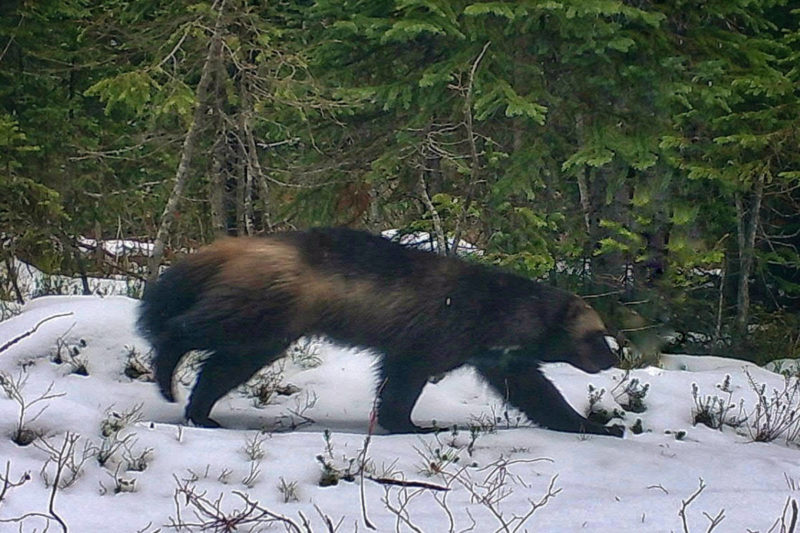The Vancouver Island wolverine may no longer roam this side of the strait, but then again, it appears the subspecies never really existed in the first place.
New research out of Vancouver Island University suggests that the Island wolverine, a red-listed species in B.C., is not, it turns out, distinct from wolverines found on the Mainland and therefore not at-risk after all.
Proving this wasn’t easy, as there have been no confirmed wolverine sightings on the Island since 1992.
“This is what makes it so interesting. They’re a bit of a sasquatch story for the Island,” said Jamie Gorrell, a VIU biology professor.
READ MORE: Wolverine research in the Kootenays boosted by citizen science
Many of the records of wolverines on the Island came from old trappers’ logs, as the animals’ pelts were sought-after and valuable, said VIU biology grad Evan Hessels.
Gorrell speculated that land-use changes over the years and fragmentation of forests have been other factors in wolverines’ decline. Whatever the reasons, wolverines on the Island are “are rare and possibly extirpated,” wrote Hessels, Gorrell, Eric Lofroth and Richard Weir in a research paper published last month in the Journal of Mammalogy.
Wolverines are shy and steer clear of human activity, which makes them hard to find at the best of times, even in areas where their population is known to be higher.
“How do you study something that you can’t see?” Gorrell asked. “Instead of trying to go out and catch wolverines from the Island, what we decided to do was take a trip back in time and go to the museums.”
Gorrell and Hessels visited the Royal B.C. Museum in Victoria and the Beaty Biodiversity Museum at UBC and scraped bits of dried flesh from skulls and drilled into skulls, teeth, claws and bones. They collected dust, broke it down chemically in the lab with enzymes, studied “certain spots in the genome” and compared multiple samples.
“The coolest part in my opinion was getting DNA out of close to 100-year-old museum specimens,” Hessels said. “It was definitely a happy moment when we were able to get success with that.”
The researchers didn’t have any preconceptions about what they might find, though Hessels said “you always hope to be surprised.”
Gorrell said the 1935 research that classified the Vancouver Island wolverine subspecies was based on skull measurements and said it’s not uncommon now for old taxonomic studies to be re-evaluated using DNA.
READ MORE: ‘Biggest bobcat I’ve ever seen’: Vernon-area photographer
Gorrell said his team’s findings could potentially lead the B.C. government to review the classification of the at-risk Vancouver Island wolverine, as wolverines elsewhere in B.C. are considered threatened but not at-risk.
“If it remains a subspecies, then we have a real problem if this subspecies is endangered or potentially extinct, which is terrible,” Gorrell said. “If they simply say it’s not a subspecies, then it maybe takes away that problem for us, and then those resources to figure it out can be diverted to another species which is maybe in a worse situation.”
The findings open up the possibility for human intervention to re-introduce wolverines on Vancouver Island, but the researchers said that’s unlikely. While increased biodiversity is desirable, introducing a predator into Vancouver Island marmot habitat would create a conflict of interest and the journal article suggests “priorities should be weighed appropriately.” And questions would need to be answered first, Gorrell said.
“If [wolverines] did get eliminated from the Island, why? What was the factor that drove them out?” he asked. “If we haven’t addressed that, then trying to bring them back would probably just be a big waste of time, effort and money.”
Theoretically, wolverines could swim over via the Discovery Islands, which could explain an unconfirmed sighting in Sayward just last month. Gorrell said there’s “no reason” to think they’re cut off from Vancouver Island.
“Multiple unconfirmed sightings are reported every year, raising the possibility that the population still exists today,” notes the journal article, adding that the animals are elusive, nocturnal and live in mostly remote regions. “Some wolverines may still roam undetected.”
Plan your future adventures throughout the West Coast at westcoasttraveller.com and follow us on Facebook and Instagram @thewestcoasttraveller. And for the top West Coast Travel stories of the week delivered right to your inbox, sign up for our weekly Armchair Traveller newsletter!











 Family Day in Victoria: Your bubble-friendly planner
Family Day in Victoria: Your bubble-friendly planner